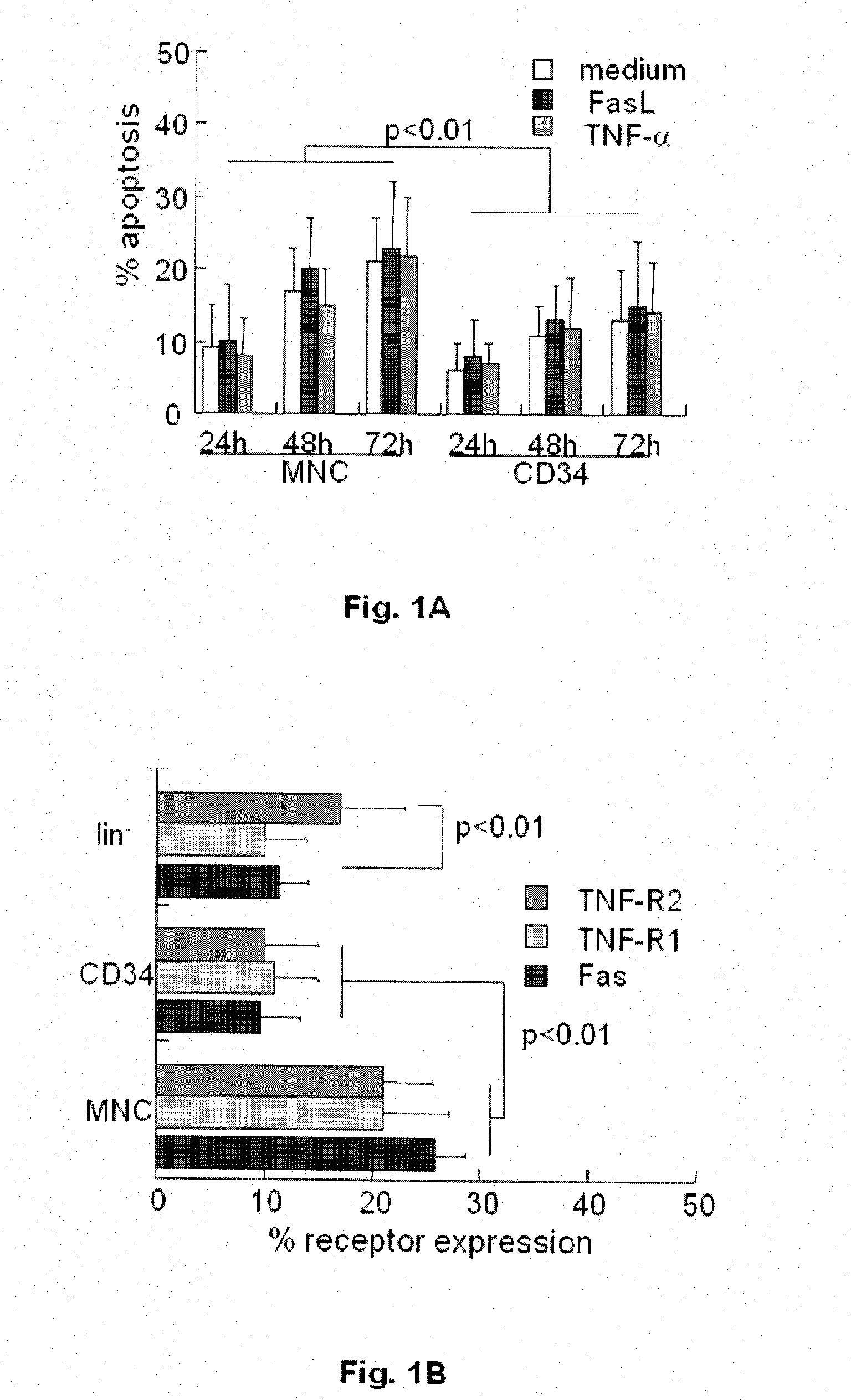Devices and methods for selecting apoptosis-signaling resistant cells, and uses thereof
a technology of resistance cells and devices, applied in the field of medical devices, can solve the problems of life-threatening situations, loss of some beneficial stem cells, and negative selection of stem cell populations, and achieve the effect of improving the clinical outcome of hematopoietic stem cells
- Summary
- Abstract
- Description
- Claims
- Application Information
AI Technical Summary
Benefits of technology
Problems solved by technology
Method used
Image
Examples
example 2
Ex Vivo Exposure of Mobilized Peripheral Blood Cells to Death Ligands
Apoptotic Activity of Death Receptor Activation In Vitro
[0140]A prevalent source of hematopoietic progenitors for transplantation is peripheral blood following mobilization with granulocyte colony stimulating factor (G-CSF) or antagonists of c-kit and CXCR4. The mobilized mononuclear cells are subsequently collected from peripheral blood by apheresis, containing a substantial number of CD34+ progenitors. Cells harvested from the peripheral blood are generally activated, therefore the periods of exposure to death ligands for selective depletion are significantly shorter. An additional difference from data presented for UCB cells is the use of cryopreserved mPB samples, the thawing of which is associated with apoptotic death of 15-25% of the cells. Fas is expressed in ˜25% of CD34+ progenitors (FIG. 6A) and considerable fractions of B lymphocytes and myeloid cells (50-65%, FIG. 6B). The TNF receptors are expressed pr...
example 3
Pretransplant Depletion of T Cells Prevents Lethal GvHD
Prevention of Lethal GvHD by Ex Vivo Selective Depletion of Host-Sensitized T Cells
[0145]Both physical depletion of T cells from donor inoculum and FasL-mediated elimination of host-reactive T cells reliably prevent GVHD. Haploidentical murine transplants (parent to child) represent the extreme risk of GvHD, characterized by high levels of mortality. In first stage experiments were recapitulated using depletion of T cells by apoptotic signals following sensitization to host antigens. Antigen-specific sensitization in vitro for 2-3 days causes T cell receptor (TCR)-mediated stimulation of responsive T cells who concomitantly upregulate Fas and its cognate ligand, resulting in execution of the apoptotic cascade in parallel to downregulation of protective antiapoptotic mechanisms. To compare this procedure to tested approach using brief exposure to apoptotic ligands ex vivo without prolonged incubation, the donors were pre-immunize...
example 4
The Impact of Ex Vivo Selective Depletion of Unstimulated Lymphocytes on Hematopoietic Cell Engraftment
[0153]Depletion of Fas-sensitive naïve splenocytes alleviates GVHD in bone marrow transplants To extend the findings of the GvH-like model to the transplant setting, the effect of Fas-mediated depletion of host-naïve cells was assessed in mice undergoing haploidentical BMT together with donor lymphocyte infusion (FIG. 12A). Irradiated F1 recipients that received 5×106 haploidentical BMC together with 1.5, 3 and 4.5 million splenocytes preincubated in control medium (H2Kb→H2Kb / d) manifest severe GvHD (FIG. 12B) and significant 10-15% weight loss (FIG. 12C). The clinical score of GvHD was corroborated by histological analysis of ear skin and liver specimens (FIG. 12D). Preincubation of the infused naïve splenocytes with FasL for 24 hours decreased the clinical GvHD score (p6 FasL-pretreated haploidentical splenocytes. It is noteworthy that this dose of T cells corresponds to doses of...
PUM
 Login to View More
Login to View More Abstract
Description
Claims
Application Information
 Login to View More
Login to View More - R&D
- Intellectual Property
- Life Sciences
- Materials
- Tech Scout
- Unparalleled Data Quality
- Higher Quality Content
- 60% Fewer Hallucinations
Browse by: Latest US Patents, China's latest patents, Technical Efficacy Thesaurus, Application Domain, Technology Topic, Popular Technical Reports.
© 2025 PatSnap. All rights reserved.Legal|Privacy policy|Modern Slavery Act Transparency Statement|Sitemap|About US| Contact US: help@patsnap.com



